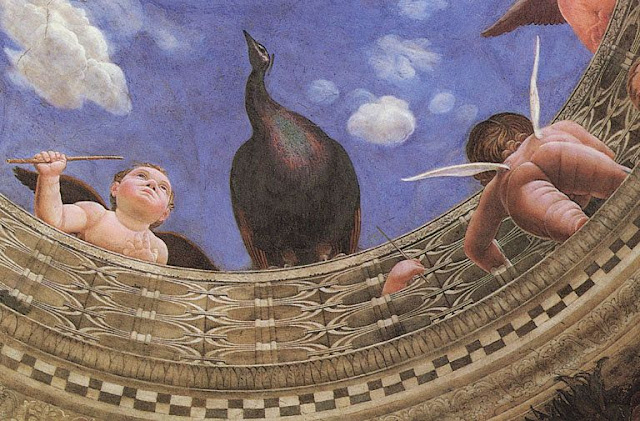MANTEGNA's CAMERA DEGLI SPOSI III: OCULUS AND CEILING
We have examined the painted walls of the "most beautiful room in the world,"
as it was known in the 15th century, the Camera degli Sposi, painted between 1465 and 1474 by Andrea Mantegna.

But the most spectacular effects or optical illusions that Mantegna created for this room were on the ceiling.

As we showed in the first entry on this room, he imagined the room as a military tent with an opening at the top, much like the hole in the Pantheon in Rome.


The inside of the top of the tent he decorates with faux medallions of portraits of eight early Roman emperors, as though they were the predecessors of the military leader living in the ducal palace, Duke Ludovico Gonzaga, who was a condottiere.
The Emperors are set in chronological order in a circle, starting with Julius Caesar, then Octavian (Augustus)




Octavian to TIBERIUS, then
CALIGULA and CLAUDIUS


Mantegna was a meticulous recorder of archaeological truth, and these fake bas-reliefs are meant to reproduce actual busts of the emperors such as those in this
collection:
You can see after a comparison how closely he followed actual sculpturesin painting these on the ceiling of the fictive tent. He keeps the emperors in chronological order in the encircling of his oculus: Julius Caesar, Augustus, Tiberius, Caligula, Claudius, Nero, Galba, and Otho. He wants the viewer to see how closely he can imitate in paint what he has seen in statuary. His deep attention to history and realistic facial features is undercut by his own
creativity and skill, however, because when people come into this room, they
skip past the emperors and are lured in and transfixed by the central image in the middle of the ceiling, the oculus that opens to the sky:

Up in the top of the ceiling Mantegna has painted a parapet through which we see the blue sky and clouds.
The parapet itself is perforated and little winged children poke their heads through the holes.
Above them and leaning over the parapet are women from the Gonzaga court, along with other putti and a peacock.

And, as if this trompe l'oeil (fooling of the eye) were not enough triumph for the artist, he depicts two of the putti standing on the small ledge molding of the parapet, from the back and from the front, but both from below looking up (di sotto in su, in Italian) to give an exhibition of his skill at foreshortening:

At that point we are made aware of another possible menace to our safety from the balcony above. The women who are circling around the parapet to look down on us are also gathered around a large potted plant sitting precariously on a stick over the parapet's edge.
When we are looking at the peacock, we don't see  this plant, but as we approach the bird, we are made aware that these women have their hands on or close to the stick, and that they could, in the next instant, move the stick, and the entire potted plant would come down on our heads!!!!!!
this plant, but as we approach the bird, we are made aware that these women have their hands on or close to the stick, and that they could, in the next instant, move the stick, and the entire potted plant would come down on our heads!!!!!!
The realism is so great from this optical illusion that visitors to the room move away from the scene towards the walls when they realize the pictorial peril coming from above.
Some of the women, including this dark-skinned woman dressed in a turban, seem to laugh in anticipation of the "dirty-joke." 
We wish as viewers to be entranced and we are, but then the artist turns the tables, so to speak, on us, and demonstrates the real power of his illusion by forcing viewers to acknowledge that the artist is the one in control. We can laugh
at his conceit (in two meanings) and laugh at ourselves for being taken in (trompe') by the realism of the image, but the artist has the last laugh in the end.
interruptions to love-making! A practical joke on all newly-weds, as the name of the room now implies: CAMERA DEGLI SPOSI. It is only because of Mantegna's archaeological truth conveyed through foreshortening, trompe d'oeil,
and the di sotto in su view that we are convinced of the realism of the parapet on the ceiling that opens up to the sky.

And it is that realism portraying a fiction that makes this ceiling oculus the painter's tour de force.
The "most beautiful room in the world" lives up to its name because the painter paints a world of human beings living together in architectural closeness or in beautiful landscapes and posed in elegant stances with colorful clothing. The beauty of his painting is nourishing.

The creatures who inhabit the oculus at the top of this elegant world, however,
remind human beings that for all our seriousness, our condition is sometimes laughable.


















No comments:
Post a Comment